Category Archives: 03. Fuel
Felt for Fuel tank XK 140
Felt used for fuel tank XK 140
Felt is used between the fuel tank and the chassis & body, but the actual amount, size and position of the various pieces of felt remain unclear from the information in the Service Parts List. Listed are the following items for the XK 140:
The (black) felt used by Jaguar is about ⅛” (or 3 mm) thick and normally 2”(or 50 mm) wide (except C8414 which is 1”or 25 mm wide). The positions of the above pieces of felt:
- Basically the XK 140 fuel tank has 3 felt strips (18” or 45 cm long) placed across the top of the tank front to rear, but the filler opening at the LH side “interferes” with one of these three strips (see 3rd bullet).
- At the LH and RH end of the tank the felt runs from the tank mounting points front to rear over the tank. The RH strip is coded C8373. For the LH strip see 3rd bullet.
- Because the fuel filler opening is placed at the LH side of the tank, the felt strip at this side is not 18” long but had to be cut in two pieces: C8371 and C 8372 with a total length of 16” leaving 2” space for the filler opening.
- The third strip (again C8373) is placed in the centre of the tank parallel to the other strips.
The (original situation) picture below shows where the LH strips went. Black glue was used to hold the strips on to the tank.
 Original
Original ![clip_image002[4] clip_image002[4]](https://www.bobine.nl/jaguar/wp-content/uploads/2013/08/clip_image0024_thumb.jpg) Restored
Restored
![clip_image002[6] clip_image002[6]](https://www.bobine.nl/jaguar/wp-content/uploads/2013/08/clip_image0026_thumb.jpg) The top strips installed on the fuel tank.
The top strips installed on the fuel tank.
There is another 44” (or 110 cm) long and only 1”(or 25 mm) wide felt strip placed along the top of the tank from side to side. This strip is positioned along the front of the top of the tank to protect the tank from rubbing on the chassis cross-member.
![clip_image002[8] clip_image002[8]](https://www.bobine.nl/jaguar/wp-content/uploads/2013/08/clip_image0028_thumb.jpg) Tank in final position including felt strips
Tank in final position including felt strips
Improved Fuel Pump pipe connections
Improved Fuel Pump pipe connections
Two copper fuel pipes are connected to the fuel pump during the assembly process of the XK 140. It concerns C7556 (Fuel pipe (centre) from rear pipe to inlet connection on fuel pump) providing fuel from the tank, and C7557 (Fuel pipe (front) from outlet connection on fuel pump to flexible hose) pumping fuel to the carbs. Apart from the fact that both pipes have a (very) sharp bend where the connection with the fuel pump is made (asking for maximum care when installing these pipes), these pipes sometimes touch the Fuel Pump Shield C8010 with the risk of damaging the fuel pipes over life.
In case the fuel pump has to be removed for inspection or repair, these copper pipes are very difficult to remove as they are partly behind the main chassis rails and there is very little space to manoeuvre these pipes away from the pump.
 Fuel pipe connections on the XK 140 and (early) XK 150
Fuel pipe connections on the XK 140 and (early) XK 150
The pipe connection system was improved many years later by Jaguar on the new 150 “S” versions, introducing a new flexible hose connection C14721 (Flexible petrol pipe from outlet side of rear petrol pump to branch on front pipe) with a banjo at one end and a compression (“olive”) connection for ⅜”copper pipe at the other end. This hose is connected to the pump using a Banjo Bolt C11488 instead of the male brass unions on the copper pipe (SU part Nº AUA 4650) as used for the XK 140.
 Fuel pipe connections on the XK 150 “S”
Fuel pipe connections on the XK 150 “S”
We can greatly improve the pipe-to-pump connections on the XK 140 and (non-“S”) XK 150 by using two of these flexible hoses (C14721) and Banjo bolts (C11488) and connecting them to the (shortened and now straight) copper pipes C7556 and C7557 using a ⅜” pipe male union that fits the female union at the end of the flexible hoses.
The result is a very “flexible” solution offering easy assembly during the restoration of your car as well as disassembly for maintenance purposes. And last but not least: it looks very professional!
Fitting a Fuel Filter in the Jaguar XK 140
Fitting a Fuel Filter in the Jaguar XK 140
It is possible to fit the “AC type” Fuel Filter of the later XK 150 (Jaguar code C13681) in a Jaguar XK 140 (FHC). This type of fuel filter can be ordered new but also found in used condition at car jumbles or on Ebay (and spare parts are also available). For the conversion the existing fuel pipes of the XK 140 have to be modified, but this can be done in a way that the original situation can be restored at all times. For my LHD XK 140 FHC I have placed the Filter on the valence panel above the RH Battery Box, close to the fuel pump pipe and the carburettors.
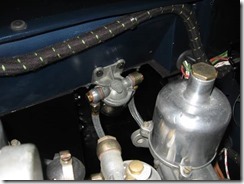 Petrol filter C 13681 in position with air filters removed
Petrol filter C 13681 in position with air filters removed
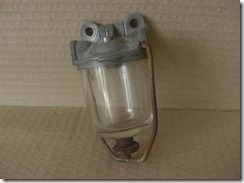 Original “AC type” fuel filter
Original “AC type” fuel filter
Required Parts
There are two alternative ways to make the connections from and to the fuel filter. Alternative 1 uses the Flexible Hose of the XK 150, but this limits the freedom to choose an optimal position for the fuel filter. Alternative 2 uses two new (but period) longer flexible fuel hoses.
The following parts are required for alternative 1:
- Petrol Filter C13681
- Flex hose + banjo C14492
- Banjo bolt UNF ½”-20
- Fibre Washer C784 (½”)
- Copper pipe 5/16”
- Male Union 9/16” UNEF-24
- Olive for 5/16” pipe
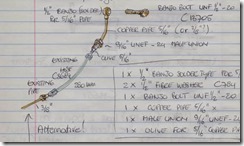 Fuel pipe from pump to filter
Fuel pipe from pump to filter
 From filter to carburettors
From filter to carburettors
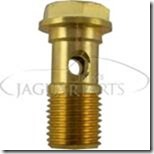 Banjo bolt C13705 (2x)
Banjo bolt C13705 (2x)
For alternative 2 the following parts are required:
As mentioned alternative 1 limits the freedom as the Flexible hose + banjo C14492 is only 255 mm long. There are longer fuel hoses (about 400 mm) available with a ½” Banjo at one end and a Female connector 9/16”-24 UNF at the other. Some of these braided fuel hoses are “Smiths Petro-Flex” branded. We need 2 of them. The existing Flex Hose C3689 is removed completely and the new (longer) flexible hose is installed instead and fitted with the banjo bolt C13705 to the inlet of the Filter. The second flexible hose is mounted with banjo bolt C13705 to the Outlet of the filter and connected to the existing Fuel Pipe C3810 which runs to the carburettors.
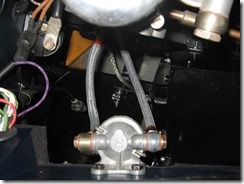 Alternative 2 using two longer flexible hoses.
Alternative 2 using two longer flexible hoses.
Replacement Filter elements
The original XK 150 fuel filter had a simple “sediment screen” Jaguar part number 7299. Later Jaguars had a paper element installed ( part number C28080). Some (cheap) elements are known to “dissolve” in petrol and create filter problems over time: buy a good filter to prevent this.
 Paper fuel filter element
Paper fuel filter element
SU Fuel pump clones
SU Fuel pump clones
There are many SU fuel pump clones made in Germany, New Zealand, Japan etc. Some examples:
- Harting, Germany (became later Hugo; not to be confused with Huco)
- Hardi, Germany (still manufacturing modern electrical fuel pumps)
- AutoPulse (Walbro), USA
- MoProd (ECCO), New Zealand
Harting Fuel Pumps

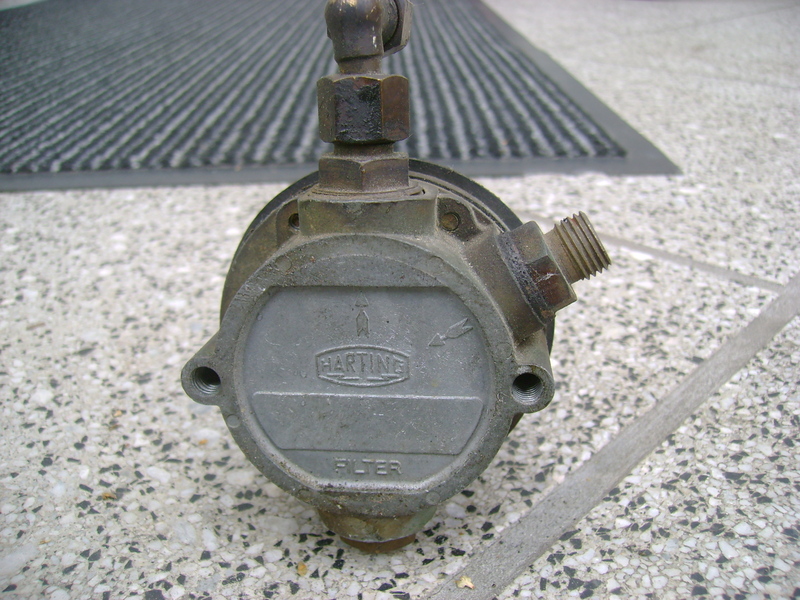 12V SD 5 58.
12V SD 5 58.
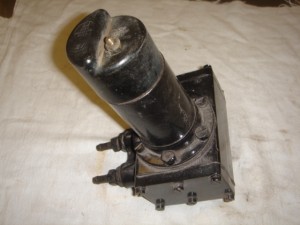
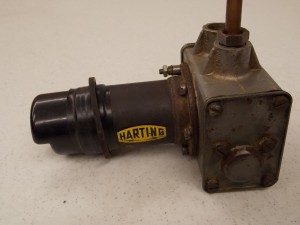 AUA 57 clone
AUA 57 clone
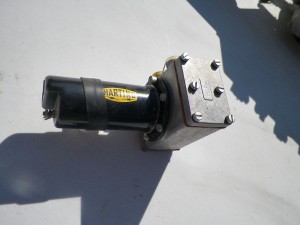
 NOS Harting pump
NOS Harting pump
Hardi fuel pumps.

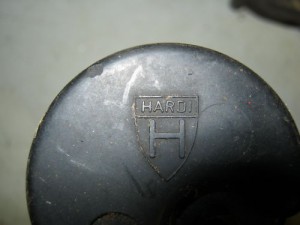 Early version
Early version
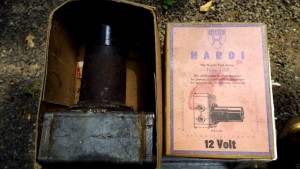 Early version J 58 in original box
Early version J 58 in original box
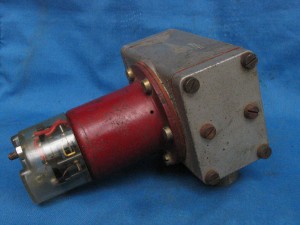
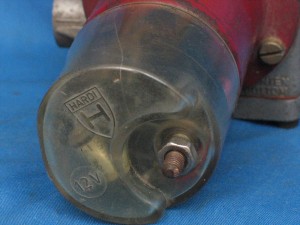 1971 version
1971 version
Technical data for the Hardi type J 58 pump:
- Capacity: 60 litre/hr (13.5 Imp. gallon/hr)
- Suction height: 1 metre (40 inches)
- Pressure: 0.2 bar.
- Contact points clearance: 1.2 mm (0.05 inch)
- Connections: BSSP ⅜ “
- Weight: 1.3 kilo
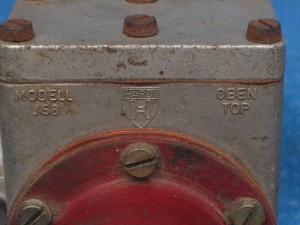
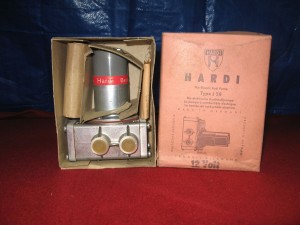 Right: later Hardi type J58
Right: later Hardi type J58
Autopulse (Walbro) USA Fuel Pumps
Moprod (New Zealand) Fuel Pumps
Moprod is a manufacturer of automotive parts including fuel pumps, mostly mechanical but also electrical ones. Some have a total plastic body. Supplies are still possible via various sources. More modern fuel pump versions have type numbers in the range FP 500E, FP 503E, etc.
 Early version
Early version
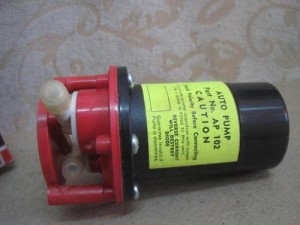
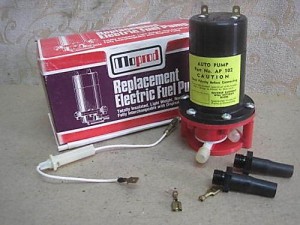 Later version FP 500E
Later version FP 500E
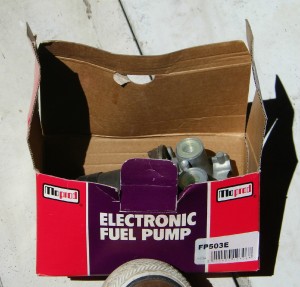
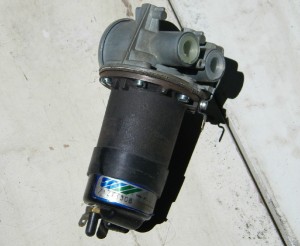 Later FP 503E
Later FP 503E
Spare Parts
Normally SU spare parts don’t fit the above clones. Spare parts are for most brands no longer available.
Points for Harting fuel pump as found on Ebay. VERA was a major US Import Auto Parts distributor for a short period in the early 1980’s, like Bap-Geon and Beck Arnley and World Parts.





